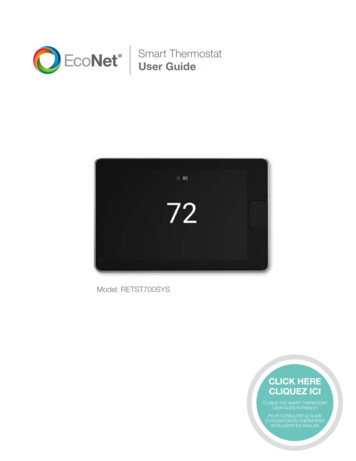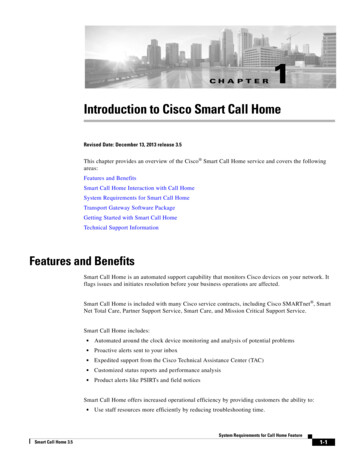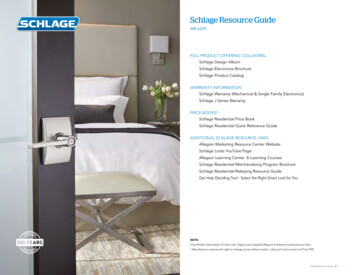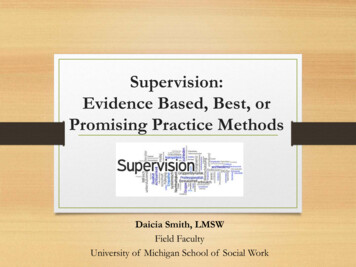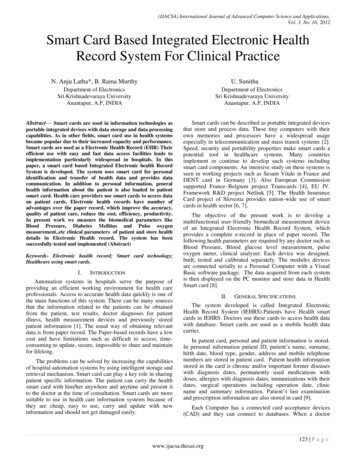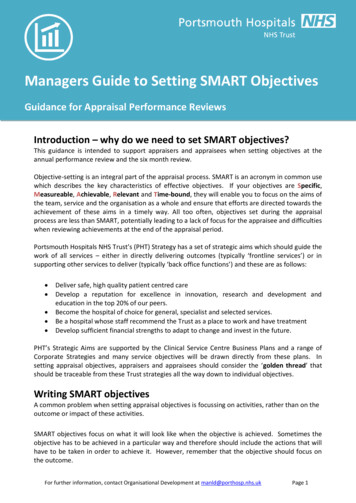
Transcription
ManagersGuide toObjectivesSetting SMARTObjectivesSetting SMART– GuidanceforGuidancefor Appraisal Performance ReviewsAppraisalIntroduction – why do we need to set SMART objectives?This guidance is intended to support appraisers and appraisees when setting objectives at theannual performance review and the six month review.Objective-setting is an integral part of the appraisal process. SMART is an acronym in common usewhich describes the key characteristics of effective objectives. If your objectives are Specific,Measureable, Achievable, Relevant and Time-bound, they will enable you to focus on the aims ofthe team, service and the organisation as a whole and ensure that efforts are directed towards theachievement of these aims in a timely way. All too often, objectives set during the appraisalprocess are less than SMART, potentially leading to a lack of focus for the appraisee and difficultieswhen reviewing achievements at the end of the appraisal period.Portsmouth Hospitals NHS Trust’s (PHT) Strategy has a set of strategic aims which should guide thework of all services – either in directly delivering outcomes (typically ‘frontline services’) or insupporting other services to deliver (typically ‘back office functions’) and these are as follows: Deliver safe, high quality patient centred careDevelop a reputation for excellence in innovation, research and development andeducation in the top 20% of our peers.Become the hospital of choice for general, specialist and selected services.Be a hospital whose staff recommend the Trust as a place to work and have treatmentDevelop sufficient financial strengths to adapt to change and invest in the future.PHT’s Strategic Aims are supported by the Clinical Service Centre Business Plans and a range ofCorporate Strategies and many service objectives will be drawn directly from these plans. Insetting appraisal objectives, appraisers and appraisees should consider the ‘golden thread’ thatshould be traceable from these Trust strategies all the way down to individual objectives.Writing SMART objectivesA common problem when setting appraisal objectives is focussing on activities, rather than on theoutcome or impact of these activities.SMART objectives focus on what it will look like when the objective is achieved. Sometimes theobjective has to be achieved in a particular way and therefore should include the actions that willhave to be taken in order to achieve it. However, remember that the objective should focus onthe outcome.For further information, contact Organisational Development at manld@porthosp.nhs.ukPage 1
SMARTSPECIFIC objectives will beclear and unambiguous. They state clearly what theexpected behaviour, achievement or outcome will be in precise terms. This enablesyou to refer back at the end of the review period and make an objective judgementabout whether the objective has been achieved.Consider - What is the goal? What outcome is needed? Think with the end result in mind Is itclear and well defined? Is it clear to anyone that has a basic knowledge of the work area?MEASURABLEobjectives enable you to see that progress is being achieved. Ameasurable objective will usually answer questions such as: How much? How many? How will I know when it is accomplished?Consider What is the measurable outcome? Know if the goal is obtainable and how far awaycompletion is. How will you know if you have been successful?ACHIEVABLE objectives are realistic and attainable.This does not mean that youshould not set stretching targets which require a change in behaviour or application ofsignificant effort; easily achievable objectives are not motivating. However, it is equallydemotivating to set objectives that are not possible to achieve, so consider theresources and time needed, and the potential limitations outside the control of theindividual, team or service.Consider How long will it take to achieve this? Is it achievable? Agree with all parties what thegoal should be to ensure clarity. Is there availability of resources, knowledge and time? Is theright support in place?RELEVANT objectives support the team, service, or Clinical Service Centre to deliver onthe Trusts priorities and strategic goals. This is where the ‘golden thread’ should bevisible. Consider how the individual objective supports the achievement of these widergoals. As well as Trust Strategy led aims, teams and services may also have aims andactions in relation to implementing clinical standards and regulations, codes of practiceor healthcare policy recommendations in their area of work.Consider Does the objective link to the team/department goals? Does the objective supportthe overall goals of the organisation? Is the objective stretching enough to ensure performanceis improved?TIME-BOUND (Timescale/Timely) objectives have clear dates, with interim milestonesif necessary, for achievement. Deadlines are important to focus effort on things thatcan get lost in day to day activity. Set a date by which the objective should be achieved,and include dates for any interim activities that are important to achieving it.Consider What is the date for completing this objective? Is there enough time to achieve thegoal or a time limit? How often will it be reviewed? Be aware of allowing too much time whichcan effect motivation or dilute performance.For further information, contact Organisational Development at manld@porthosp.nhs.ukPage 2
Tips on writing objectivesIdentify what it is that you want toachieve Consider how youwill know whenthe objective issuccessfullyachieved.Write down what you want to achieve using apositive statementMake it specificIdentify how you will measure achievementPlan the steps you need to achieve itIdentify a deadlineConsider how you will measure progressUse action verbs, for example; To increaseTo deliverTo performTo identifyTo developTo produceTo implementTo draftAvoid woolly phrases and jargon, for example; ‘Liaise with xxxxx’ – why you are liaising with xxxxx? What is itthat the liaison will achieve?‘Contribute to yyyyy’ – why is it important to contribute toyyyyy? What are you hoping to achieve?‘Learn about zzzzz’ – why are you learning about it? What willyou be able to do when you have learned about it?‘Continue to do xxxxx’ – why do you need to continue with it?What will this achieve?Stick to 5 or6 keyobjectives To improveTo ensureTo completeTo reviewTo analyseTo presentTo maintainUse the PersonalDevelopment Plan torecord developmentneeds, completing acourse should not bean objective.Don’t set too many objectivesFocus on priorities – where energy and effort should be directed – which areimportant to the achievement of the team, service and Clinical Service Centreaction plans. Having too many objectives dilutes their impact and makes ithard for you to prioritise your time. It also makes them less achievable.Don’t just restate the ‘day job’Objectives should be longer term (appraisal cycles typically look at the whole year ahead) and focus onwhat is new, or needs to be improved or done differently. It should not be a list of tasks, orregurgitation of the job description.For further information, contact Organisational Development at manld@porthosp.nhs.ukPage 3
This page is intentionally blankFor further information, contact Organisational Development at manld@porthosp.nhs.ukPage 4
Examples of SMART ObjectivesThese are examples of how to write a SMART objective, they do not profess to be technically accurate or appropriate for specific jobs but can beused as a guide to developing your own.If you have SMART objectives you would like to share, please send them to manld@porthosp.nhs.uk so they can be added to a central repository,and shared as best practice.Clinical and Non-Clinical Leadership and Management roles example objectivesQualityNot a SMART ObjectiveX Objective: “Reducehospital acquiredinfections”X Objective: “AnalysePatient Complaints”X Objective: “Review SIRIsand propose MART Objective(Specific, Achievable, Relevant)Measure of Success(Measurable) Objective: “Reduce the number ofpatients acquiring infections whilst aninpatient, by ensuring that the servicecomplies with hand hygiene and antibioticprescribing regimens” Objective: “By the end of February 2017,identify any concerning themes withinPatient complaints and engage directlywith the ward teams to agree prioritychanges to be made to improve theoverall patient experience” Infection control audits demonstrate improvedcompliance rates comparable to national average Number of Thrombophlebitis cases reduces tobelow the national average30/12/2016 Number of patient complaints has reduced tobelow national average for peers Patient feedback and priority themes clearlydisplayed in ward areas Staff reporting that they feel able to contribute toimprovements as reported by the National StaffSurvey increased against previous year28/02/2017 Objective: “Identify any themes fromSIRI’s, review and implement learningopportunities to improve the overallpatient experience” Reduction in number of incidents related toprevious SIRI’s comparable with national average Evidence of shared learning and implementedchanges to practice as a result.28/02/2017For further information, contact Organisational Development at manld@porthosp.nhs.ukPage 5
Clinical and Non-Clinical Leadership and Management roles example objectivesStandardsCompletionDate(Timescale)SMART Objective(Specific, Achievable, Relevant)Measure of Success(Measurable)X Objective: “To reducedelayed discharge ofmedically fit patients” Objective: “To reduce the number ofmedically fit patients experiencingdelayed discharge as a result of integrateddischarge planning delays by [amount%]” 100% implementation across all wards of theSAFER Patient Flow Bundle Number of patients discharged in line with targetsof SAFER Patient Flow Bundle for specific ward31/03/2017X Objective: “EnsureConstitutional Standardsare met for EmergencyDepartment performance” Objective: “To ensure all patients awaitingcare or treatment receive appropriateintervention as indicated for theircondition in line with NHS ConstitutionalStandards” Compliance with the Emergency Department 4hour standard improves in accordance withagreed trajectory CQC standards are delivered in line with the PHTCQC Improvement Plan Improvement in patient feedback/reduction incomplaints to [amount].30/12/2016X Objective: “Complete thereview of the TheatreUtilisation project” Objective: “Complete the review of theTheatre Utilisation project and presentreport to Senior Management Team (SMT)with recommendations for actions toachieve efficiency savings, together withestimated financial savings, riskassessments and equality impact analysis” Report presented to SMT by 30th Septembercontaining recommendations that are clearlyoutlined to enable SMT to make a decision30/09/2016X Objective: “Work withcolleagues in theOutpatient Booking teamto achieve serviceimprovements” Objective: “By the end of March, reducethe average waiting time to have aurologist appointment by streamliningadministrative and communicationprocesses with Outpatient Booking Centrecolleagues” Average waiting time for Urologist appointmentsreduced by [ by amount% or to amount weeks]31/03/2017Not a SMART ObjectiveFor further information, contact Organisational Development at manld@porthosp.nhs.ukPage 6
Clinical and Non-Clinical Leadership and Management roles example objectivesFinancial HealthNot a SMART ObjectiveSMART Objective(Specific, Achievable, Relevant)Measure of Success(Measurable)CompletionDate(Timescale)X Objective: “ReduceTemporary Spend” Objective: “Reduce temporary workforcespend in [department] by [amount %] bythe end of December 2016 and identifyalternative substantive workforce roles toensure a sustainable and affordableworkforce model exists; to deliver safeand effective services” Temporary workforce costs have reduced by31/12/2016[amount %] from August 2016 levels Financially in balance for pay and are meetingCost Improvement Plan (CIP) target for temporaryworkforce A clear workforce plan has been developedidentifying new role requirements with animplementation planX Objective: “Delivery of CIPTargets” Objective: “Identify and implementopportunities to ensure the departmentcontributes more than 6% of annualturnover to Cost Improvement Plans (CIP)throughout 2017/2018” Clear project plans are developed and approvedoutlining the required actions to ensure deliveryof CIP commencing from 1st April 2017 Implementation of CIP plans takes place resultingin required savings being achieved in full and onplan All risks associated with potential CIPs arereviewed and mitigatedFor further information, contact Organisational Development at manld@porthosp.nhs.ukPage 731/03/2017
Clinical and Non-Clinical Leadership and Management roles example objectivesOrganisational HealthNot a SMART ObjectiveSMART Objective(Specific, Achievable, Relevant)X Objective: “ImproveAppraisal and EssentialSkills Compliance” Objective: “Ensure all staff within yourteam engage in a robust appraisalperformance review annually, and havecompleted all Statutory and MandatoryTraining required for their specific rolewithin the mandated timeframe”X Objective: “Improve StaffEngagement” Objective: “Ensure open lines ofcommunication with all staff using StaffLed Change Methodology to implementchanges within the department”X Objective: “ImproveLeadership ability ” Objective: “Demonstrate effectiveleadership behaviours in accordance withthe elements of the NHS HealthcareLeadership Model”X Objective: “Improve staffhealth and wellbeing” Objective: “Support all staffwithin[Team]will be supported to improve andmaintain their health and wellbeingaligned to PHT Wellbeing Policy”For further information, contact Organisational Development at manld@porthosp.nhs.ukMeasure of Success(Measurable)CompletionDate(Timescale) Exceed Appraisal Target of 85% for team Staff are clear on expectations and are supportedto perform the duties of their role, includingreceiving the appropriate personal development Staff satisfaction regarding quality of objectivesas reported by the NSS has increased againstprevious year Exceed 85% Essential Skills Compliance Target forservice National Staff Survey 2016 evidences an increasein the number of key findings improving At least 2 Staff Led Change conversations held tokickstart changes in the department At least Staff Led Change champions identified,recruited and actively promoting Staff Led Change HLM self assessment and 360 Feedback processcompleted, with agreed development plan inplace to address any areas of improvementidentified31/03/2017 Health and Wellbeing will be discussed at 1:1’sand in Appraisals, and other opportunities asappropriate At least 75% of frontline staff have a flu jab All staff with sickness absence breaching TrustBradford Index triggers have an action plan forreducing absence. Sickness absence rate at [Amount%] or lower byend December 201631/12/2016Page 831/03/201731/03/2017
Front line roles example objectivesStandardsNot a SMART ObjectiveMeasure of 2017X Objective: “Join on call rota” Objective: “By the end of March2017, ensure you areappropriately skilled andcompliant with all aspects ofPhysiotherapy On-CallCompetency Framework” You able to participate in the Physiotherapy OnCall rota competently and independently Competency framework achievedX Objective: “Speed up discharges” Objective: “Take personalresponsibility to ensure patientsare safely discharged inaccordance with the SAFERPatient Flow Bundle” Number of patients safely discharged in line withtargets of SAFER Patient Flow Bundle31/10/2016X Objectives: “Desktop Procedures” Objective: “Develop andimplement Desktop Proceduresfor the recruitment process whichsupports full compliance with preemployment recruitment checks. Efficient desktop procedure is implemented andcommunicated to recruitment staff. 100% adherence to desktop procedures by allstaff participating in recruitment process.31/12/2016SMART Objective(Specific, Achievable, Relevant)Measure of Success(Measurable)Not a SMART ObjectiveOrganisational HealthSMART Objective(Specific, Achievable, Relevant)X Objective: “Increaseengagement” Objective: “Engage inorganisational priorities andsupport and develop lessexperienced colleagues”For further information, contact Organisational Development at manld@porthosp.nhs.uk Number of staff receiving development andsupport Number of ideas and opportunities fordevelopment and improvements raisedPage 9CompletionDate(Timescale)31/03/2017
Front line roles example objectivesQualityNot a SMART ObjectiveMeasure of Success(Measurable)CompletionDate(Timescale)X Objective: “Manage Friends andFamily Test” Objective: “Identify andimplement innovative ways toincrease response rates forFriends and Family Test anddevelop and implement solutionsto address issues highlighted” Response rate increased to target of [amount] Action plan developed and implemented toaddress issues Improvement in recommendation of PHT as aplace to receive care and treatment ratings forFriends and Family Test31/12/2016X Objective: “Able to administermedicines to patients withoutsupervision” Objective: “As a registered nurse,to be able to administer medicinesto patients without supervision byfollowing correct procedures fordrug administration throughbeing aware of the NMC’srequirements; Trustguidelines/policies and legalresponsibility in the management,checking and administration ofcontrolled drugs within 3 months” Within 3 months, this will be demonstrated byeffective communication with patients ensuringthat they are aware of the drugs given and why;accurate documentation on the drugs charts;administering medication via an NG / PEG tube;and by demonstrating the ability to safely andcorrectly check IV fluids, IV antibiotics and bloodtransfusions (as the 2nd nurse – but not toadminister IV fluids, IV antibiotics or bloodtransfusions)”31/12/2016SMART Objective(Specific, Achievable, Relevant)Measure of Success(Measurable)Not a SMART ObjectiveFinancialHealthSMART Objective(Specific, Achievable, Relevant)X Objective: “Reduce waste” Objective: “Identifyopportunities within the teamto reduce waste which result ina financial saving” For further information, contact Organisational Development at manld@porthosp.nhs.uk Number of opportunities raised Level of financial saving realisedPage 10CompletionDate(Timescale)31/03/2017
For further information, contact Organisational Development at manld@porthosp.nhs.uk Page 1 Setting SMART Objectives - Guidance for Appraisal Introduction - why do we need to set SMART objectives? This guidance is intended to support appraisers and appraisees when setting objectives at the


